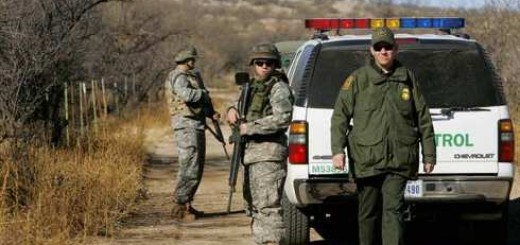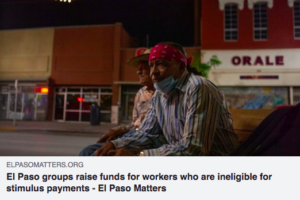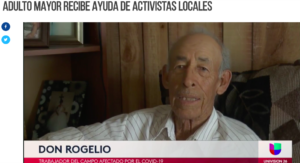In El Paso, Border Complaints Drop – Thanks to Organizing
By Brad Wong | Equal Voice News
The 2013 report from Border Network for Human Rights (BNHR) lists about two dozen incidents involving questionable law enforcement actions, immigration matters and Latino residents who live in and around El Paso, Texas.
As in: A person identified as “J.F.” reported on Feb. 20, 2013 that a police officer stopped him for a minor traffic infraction – but asked to see his social security number, said he would arrest him if he did not exit his car and threatened to summon U.S. immigration agents to the scene. A person identified as “M.B.” said that in June 2012 sheriff deputies entered his house saying they had received a report of domestic abuse – though “M.B.” explained there was no such incident and he never consented to a search.
Two people staff a table as part of Border Network for Human Rights’ (BNHR) annual “Abuse Documentation Campaign,” which asks residents in El Paso, Texas whether they believe their legal rights were violated by law enforcement, especially in terms of immigration matters. Photo courtesy of BNHR
So, when Fernando Garcia, the BNHR executive director, and volunteers tallied the answers from the annual “Abuse Documentation Campaign” in December, they discovered something unexpected. For the first time since the extended interviews of residents began 13 years ago, no one filed a report alleging a civil rights or abuse violation involving the U.S. Border Patrol in the El Paso area.
“We were skeptics. We thought we weren’t reaching out to enough people. We extended the campaign by another week,” Garcia recalled.
“We set up documentation tables in public places, in schools, churches, community centers, parks and ports of entry.”
The answer remained the same. What worked?
For the past dozen years or so, Garcia, his staff and community volunteers conducted interviews with residents that lasted up to 45 minutes. Then, they discussed their findings in public and held forums and meetings to engage law enforcement officials to find solutions – or at least start a dialogue.
They also held seminars in Spanish to let El Paso-area residents know about their rights under the U.S. Constitution, especially regarding searches and seizures and what a law enforcement official can and cannot do.
“It was 13 years of organizing and educating,” Garcia said. “This doesn’t mean that abuses don’t happen. But it is a success.”
Equal Voice News contacted the Border Patrol for a comment regarding the BNHR report, their outreach efforts and years of community meetings. A federal spokeswoman in El Paso said that she would look into the matter.
Around 1999 and 2000, Latino residents living along the U.S.-Mexico border in this Texas city had a different view of Border Patrol agents, Garcia said. When Border Patrol trucks rolled by in neighborhoods, kids playing outside would scatter.
BNHR’s first report in 2000 found that out of 100 interviews – which had location and testimony – 70 percent of the respondents said they had some type of concern with the Border Patrol, including questions over possible racial profiling, unlawful searches and verbal abuse.
Garcia took the findings to the local news media and talked about “abusive” practices. That prompted a call from the Border Patrol and a request for a meeting.
“They were upset,” Garcia recalled. “They said, ‘Why didn’t you come to us first?’”
BNHR contacted the Border Patrol several times, Garcia recalled, but the efforts led nowhere.
“But we agreed back then to open direct communication channels with the Border Patrol and to do joint community forums and to talk about the rights of individuals and the authority of the Border Patrol,” he said.
In the El Paso area, the Border Patrol created a community relations officer position, who does not wear a uniform and is unarmed. That person started attending community forums to answer questions.
“We worked with them to have someone who was not threatening,” Garcia said.
BNHR also made and passed out literature outlining the Fourth and Fifth amendments – in English and Spanish – so that residents and law enforcement officials are both aware of unreasonable searches and seizures and due process of law, said Irma Cruz, a coordinator with the community group.
By 2006 and 2007 – years after the engagement began and pressure tactics were used – the BNHR annual interviews started showing fewer community concerns involving the Border Patrol. At one point, less than half of the respondents had issues with the Border Patrol, Garcia said.
By 2009 and 2010, complaints involving the federal agency dipped to 20 percent of the respondents. “We still had problems. Every year, we met with them and gave them the results. That was part of our commitment,” Garcia said.
But the “accountability mechanism,” as he pointed out, was in place and having community residents take on the role of “human rights promoters,” as well as attorneys and professors interested in the U.S.-Mexico border, took root.
“There were a lot of elements of mistrust at the beginning. When the Border Patrol realized that BNHR wasn’t a traditional organization, that this was a community organization with many members, who are part of the process, they realized they were dealing with a community,” Garcia said.
“I believe that was key.”
BNHR and community members also were willing to hold meetings with Border Patrol officials. In some places, Garcia said, Border Patrol officials only hear blame and complaints.
“Some organizations don’t want to engage with the Border Patrol. If you do, you’re selling out,” he said. “But one day, we don’t want to document any abuse.”
Cruz, a coordinator with BNHR, pointed to one lesson that she has learned by working on this annual project and raising awareness of El Paso residents.
“The Constitution is for everyone in this country,” she said. “We are not just protesting. We are giving solutions and finding answers to problems.”




